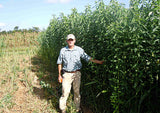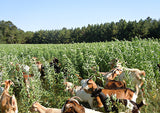CAN NOT SHIP TO MISSISSIPPI
Sunn Hemp, a tropical legume, is used in many tropical countries as the number one soil builder and cover crop for reclaiming poor land. There are millions of acres of this crop grown in other countries. Brazil calls it their number one soil builder. Sunn hemp is originally from India and has been grown since the dawn of agriculture. It has been grown as a green manure, livestock feed for forage, hay, and for non-wood fiber.
In 1931 USDA proclaimed sunn hemp excellent for building the soil. Since that time the use of sunn hemp in the US was almost unheard of. It has only been in the past few years that knowledge and benefits of this plant have taken root in the U.S.
Click the “size” box to choose different weights of bags available for this product!
 Order Online or Call (251) 827-6594
Order Online or Call (251) 827-6594
Sunn hemp is a tropical legume whose claim to fame is that, 60 days from planting, it is typically over six feet tall, adds 120 pounds of Nitrogen to the soil, 10 pounds of residual Phosphorus and 80 pounds of residual Potash transfers from the subsoil to the topsoil, supplies four tons of organic matter, is a great soil builder, as well as increasing drought tolerance and yield and cash value of the next crop. During its first 60 days, sunn hemp mines 38 lbs. of Calcium, 20 lbs. of Sulfur, and 40 lbs. of Magnesium to the surface soil. It also brings up trace nutrients that are necessary for plant growth.
Sunn hemp has an outstanding mychorizae that all other plants can utilize and benefit from. This is what brings unbelievable health, in part, to plants such as cotton or strawberries, and all other plants seeded after it.
All livestock and wildlife thrive on sunn hemp. The leaves of sunn hemp are 30 percent protein. We have not found yet anything that eats vegetation that does not thrive on sunn hemp.
Sunn hemp is not an invasive weed. In fact, it smothers out 99.9 % of all weeds and is allelopathic to Palmer Amaranth. The sunn hemp will not flower and go to seed until the days start getting shorter (mid September in Alabama). There is not enough time for those seeds to mature in our area after flowering.
Sunn hemp is resistant to root-knot and Reniform nematodes. Root-knot and reniform nematodes are a major pest in South Alabama agriculture, and root-knot nematodes are a pest in almost every home garden in South Alabama. Gardeners could plant their spring crop and then in June, July, or August plant the sunn hemp.
Sunn hemp prefers well-drained, sandy soils. Ideal pH is between 5 and 8.2, with an ideal soil temperature of 65°F (however, it will grow at temperatures as low as 48°F. The seed is best planted during Spring, at a depth between 1/4" and 2 inches. It does not need any Nitrogen, however it will respond well to Phosphorus and Potash according to a soil test. No inoculant is needed in the South, however Northern planters can use peanut rhizobium inoculant. Growth will be very slow for the first 30 days, and then will grow rapidly to six feet in height. Temperatures of 28°F or below will terminate the plant. It is an annual and will need to be planted the following year.
Here’s what you can expect when you plant Petcher Seeds’ Sunn Hemp.

Scientific Name:
Crotalaria juncea

Seed Count:
15,000 seed / LB.

Seasons:
Sunn Hemp can be planted during April and plant through August.

Planting Rate:
15 to 30 LBs. / acre
Sunn Hemp fills an incredible number of roles on the farm. It can be used for cattle, sheep and goat grazing, as well as food plot for attracting deer. It can be used for weed control and for reclaiming poor land. It can also be used for your backyard garden. You can read more about these and other uses for Sunn Hemp at our Sunn Hemp 101 section.
CAN NOT SHIP TO MISSISSIPPI


 Newsletter
Newsletter
 Contact
Contact
 My cart (0)
My cart (0)




















 Have a question?
Have a question?